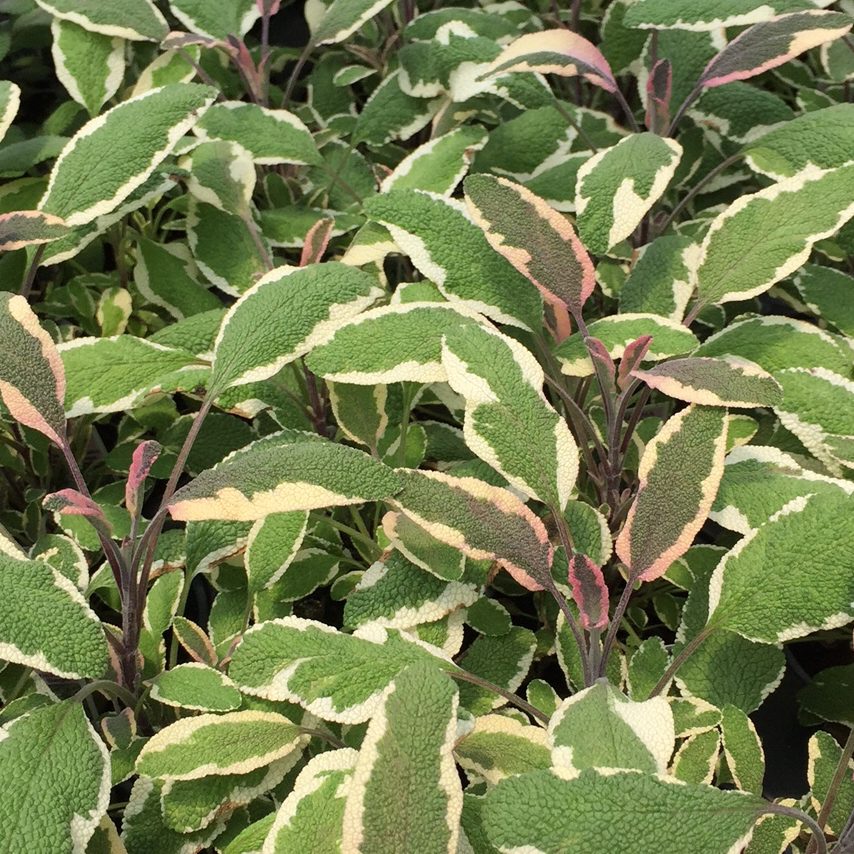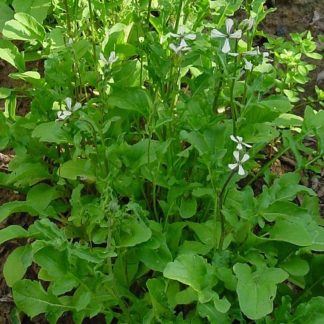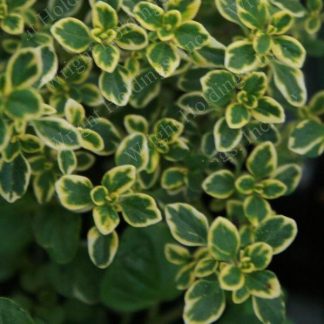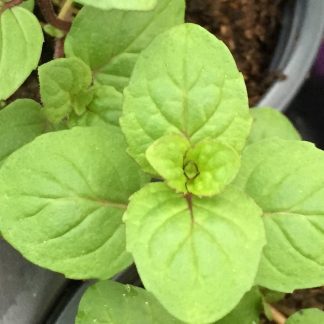Description
Sage – Salvia officinalis ‘Tricolor’: A Garden Jewel With Flavor and Flair
There is something truly special about herbs that bridge the gap between beauty and function. Sage has always been one of those herbs. But when you meet Salvia officinalis ‘Tricolor,’ it takes this magic to another level. This striking plant combines rich culinary tradition with dramatic ornamental foliage, creating an herb that is as welcome in a decorative border as it is in the kitchen.
A Look at Its Striking Appearance
Tricolor sage earns its name from the three colors splashed across each leaf. Deep green forms the base, creamy white streaks add brightness, and soft purple or pink tones wash over the edges. Together, they create a painterly effect that looks almost hand-brushed. This variegation intensifies in cooler temperatures, making it a plant that transforms with the seasons.
The leaves are slightly fuzzy, oval-shaped, and release that unmistakable earthy, peppery aroma the moment they’re touched. In summer, the plant produces delicate lavender-blue blooms that attract bees and other pollinators. These flowers rise just above the foliage, adding another layer of interest.
Growth Habit and Size
Tricolor sage is a perennial subshrub that grows to about 12–18 inches tall and spreads around 18–24 inches wide. Its compact form makes it ideal for small gardens, raised beds, or decorative pots. Over time, it can become slightly woody at the base, but light pruning keeps it tidy and vigorous.
Why Gardeners Love Tricolor Sage
This variety stands out for more than just looks:
- Multi-Purpose Beauty: It works as an edible herb and as an ornamental plant. Few herbs check both boxes so well.
- Low Maintenance: Once established, it thrives with minimal care and tolerates a range of conditions.
- Drought Tolerance: Like other sages, it handles dry spells with ease once mature.
- Pollinator Magnet: Its summer flowers feed bees and butterflies, supporting garden biodiversity.
Growing Conditions for Success
Tricolor sage thrives when given conditions similar to its Mediterranean origins. Keep these factors in mind:
Light
Full sun is best for vibrant foliage and strong flavor. It will tolerate partial shade, but the colors may be less vivid.
Soil
Well-draining soil is critical. Sandy or loamy soils mimic its native habitat. Heavy clay should be amended with compost or sand to prevent root rot.
Watering
Moderate water is ideal. Let the soil dry slightly between waterings. Overwatering is the quickest way to harm the plant.
Temperature and Hardiness
This sage is hardy in USDA zones 6–9. In colder climates, grow it in containers so it can be overwintered indoors.
Planting and Care Tips
Plant tricolor sage in spring after the last frost, or in fall in warmer regions. Space plants about 18 inches apart to allow airflow. Here are some care practices to keep it thriving:
- Mulch lightly around the base to retain moisture and suppress weeds, but avoid piling mulch against the stems.
- Prune in spring to encourage bushy growth and remove any dead wood.
- Harvest regularly to stimulate new leaves and prevent legginess.
- Replace every 3–4 years if plants become too woody or lose vigor.
Culinary Uses
Though beautiful, tricolor sage doesn’t sacrifice flavor. It retains the classic earthy, slightly peppery taste of common sage, making it perfect for:
- Seasoning roasted meats like pork, chicken, or turkey
- Infusing butter or olive oil for sauces
- Adding depth to stuffing, soups, and stews
- Frying whole leaves for crispy garnishes
Because the leaves are variegated, they also add visual appeal to dishes as fresh sprigs or edible garnishes.
Ornamental and Design Appeal
Beyond the kitchen, tricolor sage is a showstopper in ornamental plantings. Its variegated foliage pairs beautifully with solid green herbs or contrasts with silver plants like lavender and lamb’s ear. It works well in:
- Mixed herb gardens for color contrast
- Container plantings on patios or balconies
- Border edges for vibrant definition
- Pollinator-friendly gardens alongside other blooms
Propagation
Tricolor sage is most reliably propagated through cuttings rather than seeds, since variegation is not stable in seedlings. Take softwood cuttings in spring or early summer, dip them in rooting hormone, and plant in well-draining potting mix. Keep moist until rooted.
Common Problems and Solutions
- Root Rot: Caused by poor drainage or overwatering. Use raised beds or amend heavy soil.
- Aphids or Spider Mites: Hose off or treat with insecticidal soap.
- Leggy Growth: Regular pruning and harvesting keep the plant compact.
Companion Planting
Tricolor sage pairs well with other Mediterranean herbs like rosemary, thyme, and oregano, which share similar soil and water needs. Its flowers also benefit vegetables by attracting pollinators. Avoid planting near overly moist-loving plants like basil.
Overwintering in Cold Climates
In zones colder than 6, grow tricolor sage in containers or dig up and pot plants in fall. Place them in a bright window or cool greenhouse. Water sparingly through winter, just enough to keep the soil from drying out completely.
A Herb for Gardeners and Cooks Alike
Tricolor sage is a rare find in the herb world. It offers year-round interest, robust culinary use, and ornamental charm in one compact plant. For anyone looking to elevate their garden design and flavor their kitchen creations, this plant is a treasure worth growing.
Bringing Color and Flavor Together
Tricolor sage isn’t just an herb; it’s a celebration of beauty and usefulness woven into a single plant. From its striking foliage to its classic flavor, it brings joy to cooks, gardeners, and pollinators alike. Grow it once, and it often becomes a garden staple you’ll return to year after year.




